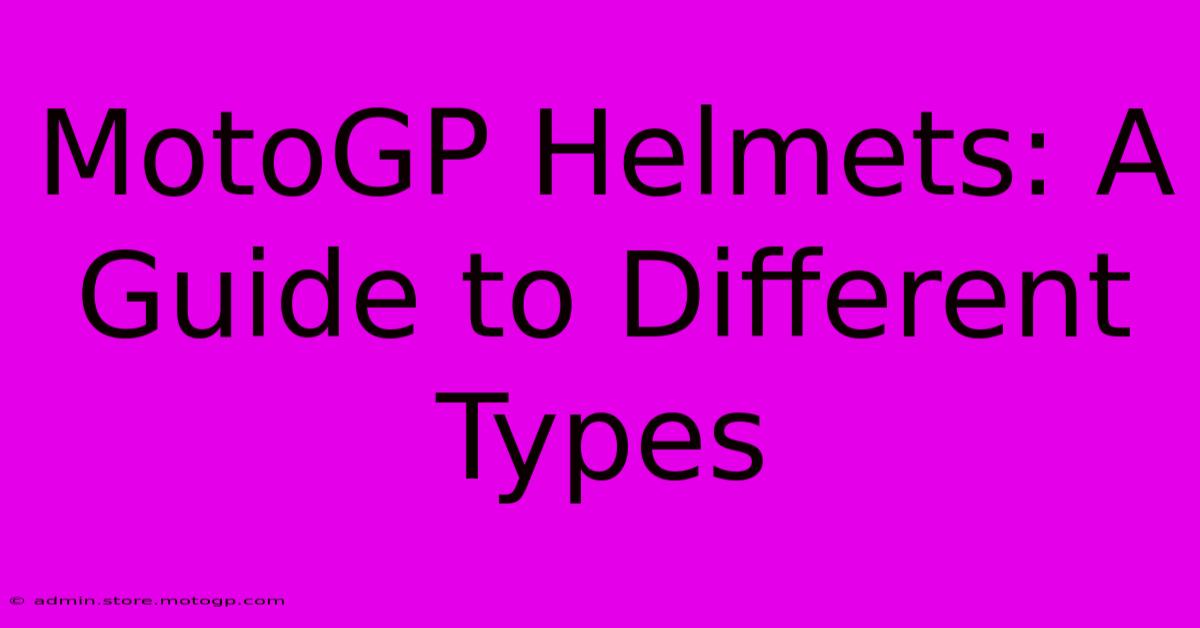MotoGP Helmets: A Guide To Different Types

Table of Contents
MotoGP Helmets: A Guide to Different Types
MotoGP racing demands the absolute best in safety and performance, and this is acutely reflected in the helmets worn by the world's top riders. These aren't just any helmets; they're meticulously engineered pieces of equipment designed to withstand incredible forces and offer unparalleled protection. But with so many different types and features, choosing the right MotoGP helmet (or even a similar high-performance helmet for street use) can be daunting. This guide breaks down the different types and key considerations.
Understanding the Key Differences
Before diving into specific types, let's understand the core factors differentiating MotoGP helmets from standard helmets:
-
Shell Material: MotoGP helmets primarily utilize carbon fiber or advanced composite materials. These are incredibly lightweight yet incredibly strong, crucial for minimizing head injuries during high-speed crashes. Standard helmets might use fiberglass or polycarbonate, offering good protection but often at the cost of weight.
-
Safety Standards: MotoGP helmets exceed even the strictest safety standards like ECE 22.06, Snell M2020, or even more stringent internal team specifications. These standards go beyond minimum requirements, ensuring comprehensive protection against impacts, penetration, and more.
-
Aerodynamics: Aerodynamics play a significant role at MotoGP speeds. Helmets are designed to minimize wind resistance and turbulence, optimizing rider performance and stability. This often involves complex shaping and potentially integrated spoilers or air vents.
-
Weight: Every gram counts. Lightweight helmets reduce neck strain during races, contributing to rider fatigue management and ultimately, better performance.
Types of MotoGP Helmets (and similar high-performance helmets):
While there isn't a strict categorization of "types" within MotoGP helmets, we can differentiate them based on features and design philosophies:
1. Full-Face Helmets: The Standard for MotoGP
The overwhelming majority of MotoGP riders use full-face helmets. These offer the most comprehensive protection, covering the entire head and face. Key features within these helmets include:
- Multiple Shell Sizes: Ensuring a precise fit for different head sizes is crucial for optimal safety and comfort.
- Advanced Ventilation Systems: Critical for managing heat and moisture buildup during intense races.
- Visor Mechanisms: High-quality visors with quick-release mechanisms and anti-fog/anti-scratch treatments are standard.
- Emergency Release System: Allows for quick helmet removal in case of an accident.
2. Modular Helmets (Limited Use in MotoGP):
While less common in MotoGP, some riders might use modular helmets during specific events or testing. These offer the convenience of a flip-up chin bar, but typically sacrifice some weight and aerodynamic efficiency compared to full-face helmets. The tradeoff of convenience versus performance usually makes them unsuitable for top-tier racing.
3. Airbag-Integrated Helmets: A Growing Trend
The integration of airbag systems is becoming increasingly popular. These systems deploy upon impact, providing an extra layer of protection for the head and neck. These are often combined with a full-face helmet design.
Choosing Your Helmet (Outside of MotoGP):
While you might not be competing in MotoGP, the principles of selecting a high-performance helmet remain relevant. Consider these factors when buying a top-tier helmet:
- Your Riding Style: Aggressive sport riding will demand a helmet with superior aerodynamics and protection compared to more leisurely touring.
- Budget: High-performance helmets are an investment. Set a realistic budget and research models within that range.
- Fit: A properly fitting helmet is paramount for safety and comfort. Try on several helmets to find the perfect fit.
- Features: Consider the importance of features like integrated communication systems, sun visors, and pinlock inserts.
Conclusion:
MotoGP helmets represent the pinnacle of motorcycle helmet technology. While you might not need the same level of extreme protection for street riding, understanding the features and considerations discussed here will help you make an informed decision when choosing a high-performance helmet that prioritizes safety and comfort. Remember to always prioritize safety and choose a helmet that meets or exceeds relevant safety standards.

Thank you for visiting our website wich cover about MotoGP Helmets: A Guide To Different Types. We hope the information provided has been useful to you. Feel free to contact us if you have any questions or need further assistance. See you next time and dont miss to bookmark.
Featured Posts
-
Yamaha V4 Designed For The Ultimate Boating Experience
Feb 19, 2025
-
Moto 3 Bikes Experience The Thrill Of Moto 3 Racing
Feb 19, 2025
-
The Moto Gp Riders We Ll Never Forget
Feb 19, 2025
-
F1 Qualifying Get Todays Full Results Now
Feb 19, 2025
-
Cota Store The Official Source For Cota Merchandise
Feb 19, 2025
